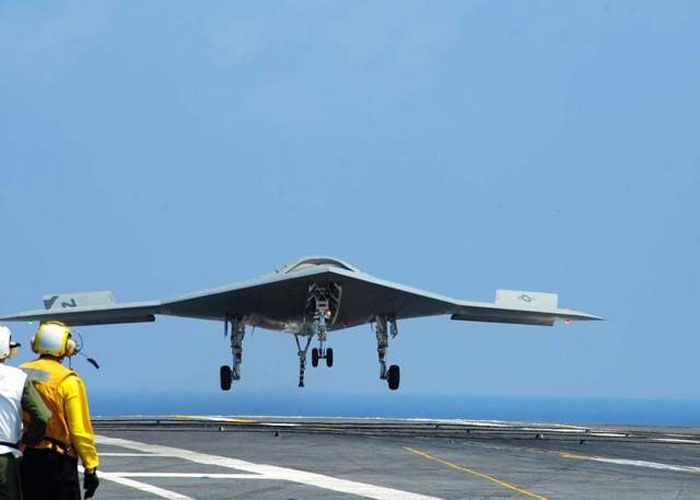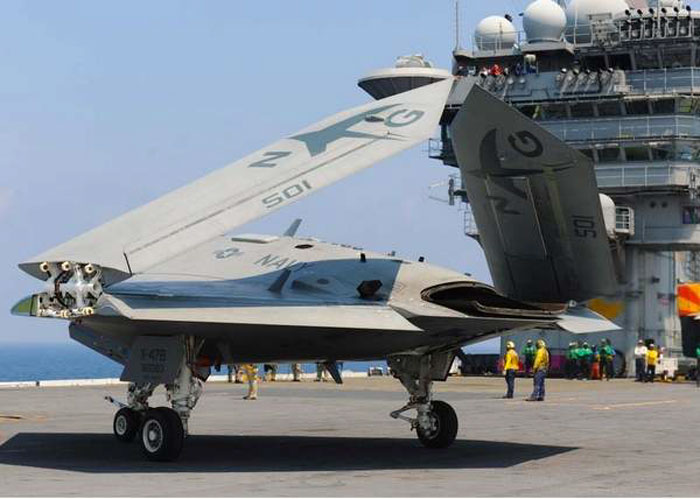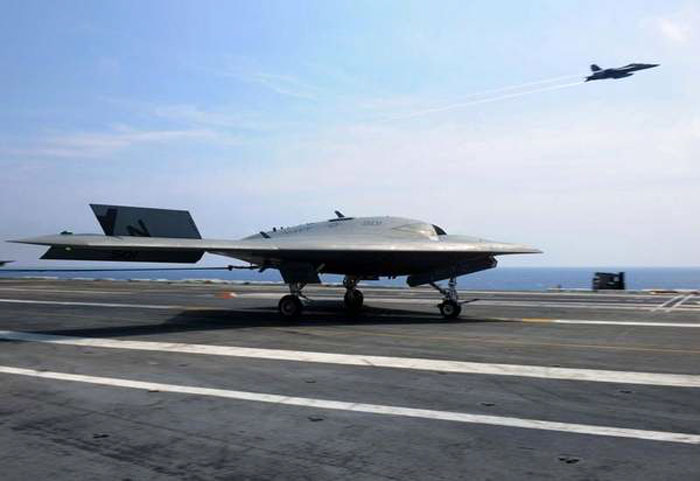.

An X-47B lands the aircraft carrier Theodore Roosevelt. (MCSA Alex Millar/Navy)
.
NORFOLK, VA. — It was one small button push for man and one giant catapult launch for the US Navy’s unmanned air combat program Sunday as the X-47B flew its first takeoffs and landings with F/A-18s on the aircraft carrier Roosevelt.
Off the Virginia coast, two Hornets and one X-47B practiced launches and traps in the same pattern, testing the unmanned jet’s ability to take off and land safely, then move out of the way to allow a manned aircraft to come in right behind it.
It was a first for the US Navy’s Unmanned Combat Air System Aircraft Carrier Demonstration program, said Rear Adm. Mat Winter, program executive officer for Unmanned Aviation and Strike Weapons at Naval Air Systems Command in Patuxent River, Maryland.
.

The goal for the day was to launch and land the Hornets within 90 seconds of the X-47B. After a couple tries, the team was able to land the X-47B, fold its wings and move it out of the way to make way for the manned jet within 90 seconds. / MCSA Alex Millar/Navy
.
The testing was an important step in the US Navy’s push to advance its aerial strike and surveillance technology, figuring out where unmanned capabilities can enhance the effectiveness of the carrier air wing.
“It’s not an unmanned over all others,” Winter said. “It’s a blending of manned and unmanned capabilities.”
The X-47B isn’t like other unmanned aerial systems. For starters, it’s bigger than a fighter jet, with a 62-foot wingspan, 17 feet wider than the F/A-18E Super Hornet.
It also operates autonomously, rather than having a pilot on the ground moving a joystick and throttle. It flies preprogrammed routines, so the deck operator only controls the jet while it’s moving in and out of position on the flight deck. From there, it’s a series of button pushes to make it fly.
The X-47B flew about half a dozen programs during the demonstration, said UCAS-D program manager Capt. Beau Duarte. Those included takeoff, flying downwind, turning around to the back of the carrier, landing, folding its wings and others, he said.
The goal for the day was to launch and land the Hornets within 90 seconds of the X-47B. After a couple tries, the team was able to land the X-47B, fold its wings and move it out of the way to make way for the manned jet within 90 seconds.
A regular Hornet wing lands jets at closer to 60-second intervals, Winter said. As tests continue into the week, Duarte said they would try to tighten up the times if possible.
“We’ll see what level of interaction between the two aircraft we can achieve, and we will let that feed our future concept of operations,” he said.
The next program goal is to try an aerial refueling of the unmanned aircraft, which requires new software programming, Duarte said.
The X-47B is funded through fiscal year 2015, but beyond that its future is unknown. However, its technology will feed into the follow-on Unmanned Carrier-Launched Airborne Surveillance and Strike program, Winter said.
Once the UCLASS hits the fleet in 2020 to 2021, the US Navy will figure out who will operate the aircraft and how it fits into the current carrier air wing structure.
“Whether that person is a pilot, a naval flight officer or enlisted, we will figure it out in those early operational deployments,” Duarte said.
From there, feedback will determine whether X-47B’s surveillance and strike capabilities are more suited to a stand-alone squadron, Winter said, or perhaps as part of an E-2 Hawkeye surveillance or F/A-18 attack squadron.
.

The testing was an important step in the Navy's push to advance its aerial strike and surveillance technology, figuring out where unmanned capabilities can enhance the effectiveness of the carrier air wing. / MCSA Alex Millar/Navy
.
Quelle: DEFENSE NEWS
4904 Views
